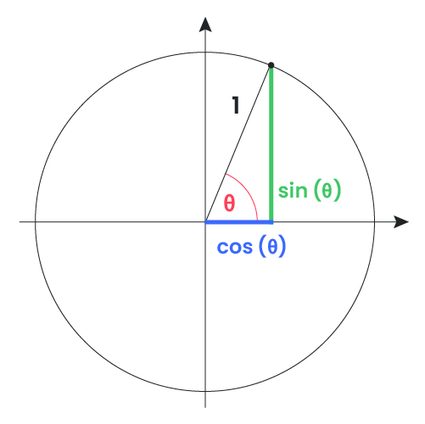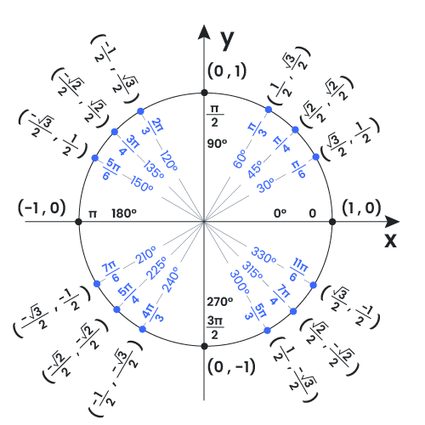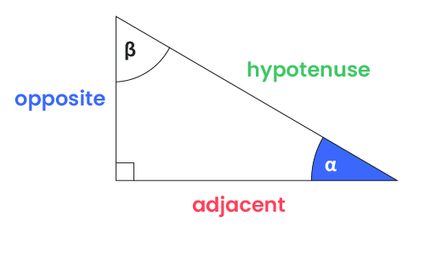Trig Calculator
Welcome to this trigonometric calculator, a trig tool created to:
- Calculate any trigonometric function by inputting the angle at which you want to evaluate it; and
- Solve for the sides or angles of right triangles by using trigonometry.
Keep reading this article to learn more about trigonometric functions and the trig identities that relate them.
The sine and cosine trigonometric functions
Trig functions are functions that take an angle as the argument. We define these functions by using the angle of a right triangle that is inserted in a unitary circle. Then, we relate that angle to the sides of such a triangle.
As the right triangle is circumscribed in a unit circle, the length of its hypotenuse equals the circle's radius (which equals one unit).

Sine and cosine are the fundamental trigonometric functions arising from the previous diagram:
- The sine of theta (
sin θ) is the hypotenuse's vertical projection (green line); and - The cosine of theta (
cos θ) is the hypotenuse's horizontal projection (blue line).
We can rotate the radial line through the four quadrants and obtain the values of the trig functions from 0 to 360 degrees, as in the diagram below:
- For example, for an angle that leads to the second quadrant (90-180°), the cosine will be negative as the horizontal projection of the hypotenuse will point to the left. That's the case of 135°, whose cosine (horizontal projection, or x coordinate) equals -√2/2.
- For the third quadrant (180-270°), the cosine and the sine of the angles lying on it will be negative.
- For the fourth quadrant angles (270-360)°, the cosines will be positive and the sines negative.

Beyond 360 degrees
The previous behavior repeats cyclically, so trigonometric functions are not limited to 360°. We can keep rotating counterclockwise, and once we reach 360 degrees, the sine and cosine functions start to repeat the same behavior. As a consequence, we can relate the functions at different angles with the following trig identities for any n integer:
sin(θ + 2πn) = sin(θ);cos(θ + 2πn) = cos(θ);and
For example a trig function at 90° (π/2) will be mathematically the same as at 450° (5π/2), as 5π/2 = π/2 + 2π.
Negative angles
Negative angles imply the same way to calculate sine and cosine (vertical and horizontal projections, respectively), with the difference that angular rotation occurs in the clockwise direction. For example, a trigonometric function at 270° is the same as at -90°, as their radial lines are the same (you can check it with this calculator)
Tan, cot, sec, and csc, calculated from trig identities.
Once you know the value of sine and cosine, you can use the following trigonometric identities to obtain the values of the other four functions:
-
Tangent is the sine-to-cosine ratio
tan(α) = sin(α)/cos(α) -
Cosecant is the reciprocal of the sine
csc(α) = 1/sin(α) -
Secant is the reciprocal of the cosine
sec(α) = 1/cos(α) -
Cotangent is the reciprocal of the tangent
cot(α) = 1/tan(α)
Trigonometry in a right triangle
From the previous analysis, we can obtain some valuable formulas that relate the angle of a right triangle to its sides. Of course, this doesn't limit to unit circles, so we can use it for hypotenuses of any length.

We relate the angle of the right triangle to its sides in the following way:
sin(α) = opposite/hypotenuse
cos(α) = adjacent/hypotenuse
tan(α) = opposite/adjacent
Remember that cotangent, secant, and cosecant are the inverse of the previous functions:
csc(α) = 1/sin(α) = hypotenuse/opposite
sec(α) = 1/cos(α) = hypotenuse/adjacent
cot(α) = 1/tan(α) = adjacent/opposite
You also can apply the previous formulas for the other acute angle (β), but consider that the legs of the triangle will switch: the adjacent will now be the hypotenuse and vice versa.
Other trigonometric calculators
If you like this calculator, you may find these other tools interesting:
FAQs
How do I solve a 45-90-45 degree triangle by trig formulas?
If one leg of a 45 45 90 triangle is equal to a, then:
- The second leg also equals a;
- The hypotenuse equals a√2 (from the hypotenuse formula c = √(a² + a²) = a√2);
- The area is A = a²/2; and
- The perimeter equals a(2 + √2) (the sum of the two sides plus the hypotenuse).
What are the values of the 6 trig functions at 90 degrees?
The values of the 6 trig functions for 90 degrees (π/2) are the following ones:
- sin(90°) = 1;
- cos(90°) = 0;
- tan(90°)= undefined;
- cot(90°) = 0;
- sec(90°) = undefined; and
- csc(90°) = 1.
